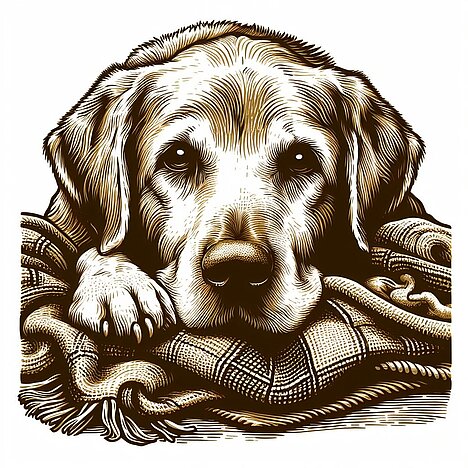Age-related amyloidosis

Senile amyloidosis is a disease that mainly affects older dogs. Abnormal proteins, known as amyloids, are deposited in various organs and disrupt their function. In this blog post, you can find out more about the causes, symptoms, diagnosis and treatment of this disease.
What is amyloidosis?
Amyloidosis is a collective term for various diseases in which amyloids accumulate in the body. Amyloids are fibrous proteins that are normally broken down and excreted. If this process is disrupted, they can accumulate between the cells and damage the tissue. The amyloid deposits can occur in one or more organs and lead to chronic symptoms.
There are various forms of amyloidosis, which differ according to the type of amyloid and the cause. The most common forms in dogs are
- Secondary amyloidosis (AA): this occurs as a result of chronic inflammation or infection, for example in diabetes mellitus, renal insufficiency or liver inflammation. An acute-phase protein called serum amyloid A (SAA) is formed in increased quantities and converted into amyloid.
- Primary amyloidosis (AL): This occurs without any known pre-existing disease and is caused by an overproduction of light chains (LC), which are components of antibodies. This form is very rare in dogs.
- Familial amyloidosis (AF): This is genetic and mainly affects certain breeds such as Shar-Pei, Beagle and Collie. A defective protein called transthyretin (TTR) is formed and converted into amyloid.
- Age-related amyloidosis (AE): This develops in older dogs and is caused by an age-related decrease in the proteinases responsible for the breakdown of amyloids.
How do you recognize amyloidosis?
The symptoms of amyloidosis depend on which organs are affected. The most common organs are the kidneys, liver, heart and digestive tract. The symptoms can be very non-specific and only appear in advanced stages. Possible signs are
- Pale or yellow mucous membranes
- Increased thirst and urine output
- dehydration
- Vomiting and diarrhea
- Abdominal pain and flatulence
- Loss of appetite and weight loss
- Fever and weakness
- Swollen joints and pain
- Cardiac arrhythmia and shortness of breath
To make a diagnosis, the vet must take a tissue sample and examine it under the microscope. He can see the typical amyloid deposits, which appear bright red with a special stain (Congo red) and show an apple-green birefringence in polarized light. He can also carry out blood and urine tests to check the function of the affected organs. In some forms of amyloidosis, a genetic test can also be helpful.
How is amyloidosis treated?
Unfortunately, there is no cure for amyloidosis. Treatment aims to alleviate the symptoms and combat the underlying disease. This includes:
- A change of diet to a low-protein and low-salt diet to reduce the burden on the kidneys
- The administration of medication to lower blood pressure, improve heart function and prevent blood clots
- The administration of antibiotics or anti-inflammatory drugs for infections or inflammation
- The administration of fluid therapy for dehydration
- The administration of blood transfusions in the event of bleeding
- The administration of immunosuppressants or chemotherapy for primary amyloidosis
- Administration of tafamidis, a drug that prevents the formation of TTR amyloid, for familial amyloidosis
The prognosis for dogs with amyloidosis is usually poor, as the disease is often diagnosed late and the organ damage is irreversible. Life expectancy depends on the form, stage and therapy. Secondary amyloidosis can improve if the underlying disease is successfully treated. In primary and familial amyloidosis, early diagnosis and treatment can slow down the progression of the disease. In the case of senile amyloidosis, good care and support can improve the quality of life.
How can amyloidosis be prevented?
Preventing amyloidosis is difficult, as the causes are often unknown or cannot be influenced. Some measures that can help are
- A regular health check-up at the vet to detect and treat chronic diseases at an early stage
- A balanced diet and sufficient exercise to prevent obesity, diabetes and cardiovascular problems
- Good hygiene and vaccination to avoid infections
- Genetic counseling and testing if you want to breed a dog of a risk breed
Amyloidosis is a serious condition that can shorten your dog's life. If you notice signs of amyloidosis in your dog, you should see a vet as soon as possible. The earlier the diagnosis is made, the better the chances of controlling the disease and maintaining your dog's quality of life.
The authors assume that a veterinarian should be consulted if an animal is ill and that medication should only be taken after consultation with a doctor or pharmacist. Only an individual examination can lead to a diagnosis and treatment decision.
We help you find the nearest vet → This way